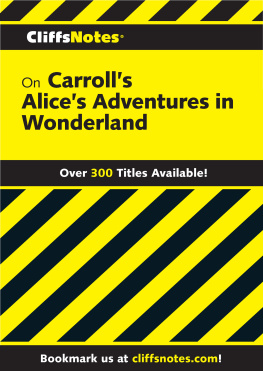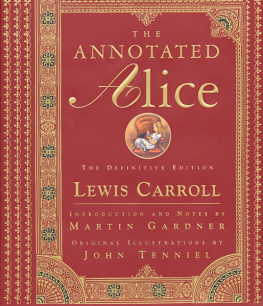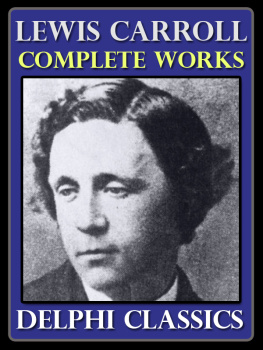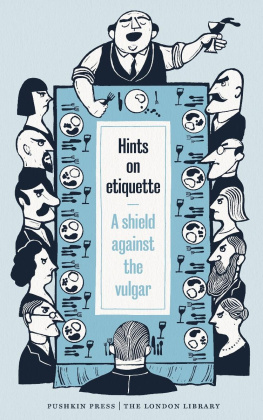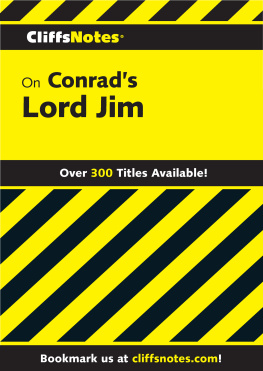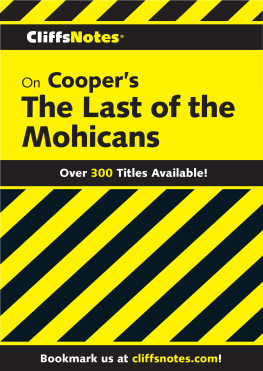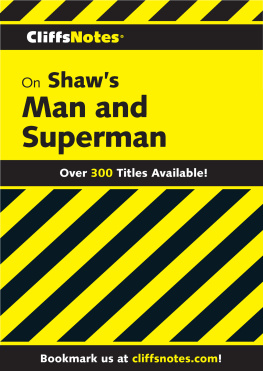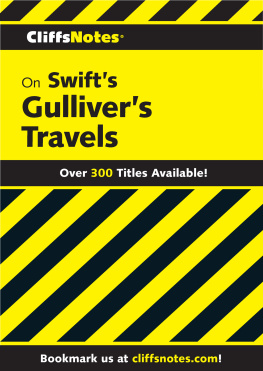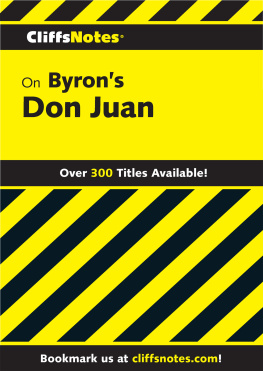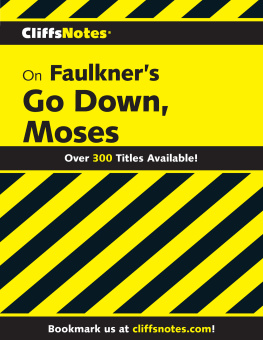Lewis Carroll - CliffsNotes on Carrolls Alices Adventures in Wonderland
Here you can read online Lewis Carroll - CliffsNotes on Carrolls Alices Adventures in Wonderland full text of the book (entire story) in english for free. Download pdf and epub, get meaning, cover and reviews about this ebook. year: 1999, publisher: HMH Books, genre: Children. Description of the work, (preface) as well as reviews are available. Best literature library LitArk.com created for fans of good reading and offers a wide selection of genres:
Romance novel
Science fiction
Adventure
Detective
Science
History
Home and family
Prose
Art
Politics
Computer
Non-fiction
Religion
Business
Children
Humor
Choose a favorite category and find really read worthwhile books. Enjoy immersion in the world of imagination, feel the emotions of the characters or learn something new for yourself, make an fascinating discovery.
- Book:CliffsNotes on Carrolls Alices Adventures in Wonderland
- Author:
- Publisher:HMH Books
- Genre:
- Year:1999
- Rating:5 / 5
- Favourites:Add to favourites
- Your mark:
- 100
- 1
- 2
- 3
- 4
- 5
CliffsNotes on Carrolls Alices Adventures in Wonderland: summary, description and annotation
We offer to read an annotation, description, summary or preface (depends on what the author of the book "CliffsNotes on Carrolls Alices Adventures in Wonderland" wrote himself). If you haven't found the necessary information about the book — write in the comments, we will try to find it.
This CliffsNotes guide includes everything youve come to expect from the trusted experts at CliffsNotes, including analysis of the most widely read literary works.
CliffsNotes on Carrolls Alices Adventures in Wonderland — read online for free the complete book (whole text) full work
Below is the text of the book, divided by pages. System saving the place of the last page read, allows you to conveniently read the book "CliffsNotes on Carrolls Alices Adventures in Wonderland" online for free, without having to search again every time where you left off. Put a bookmark, and you can go to the page where you finished reading at any time.
Font size:
Interval:
Bookmark:
Copyright 1999 Houghton Mifflin Harcourt Publishing Company
All rights reserved.
For information about permission to reproduce selections from this book, write to or to Permissions, Houghton Mifflin Harcourt Publishing Company, 3 Park Avenue, 19th Floor, New York, New York 10016.
www.hmhco.com
cliffsnotes.com
The publisher and the author make no representations or warranties with respect to the accuracy or completeness of the contents of this work and specifically disclaim all warranties, including without limitation warranties of fitness for a particular purpose. No warranty may be created or extended by sales or promotional materials. The advice and strategies contained herein may not be suitable for every situation. This work is sold with the understanding that the publisher is not engaged in rendering legal, accounting, or other professional services. If professional assistance is required, the services of a competent professional person should be sought. Neither the publisher nor the author shall be liable for damages arising herefrom. The fact that an organization or website is referred to in this work as a citation and/or a potential source of further information does not mean that the author or the publisher endorses the information the organization or website may provide or recommendations it may make. Further, readers should be aware that Internet websites listed in this work may have changed or disappeared between when this work was written and when it is read.
Trademarks: CliffsNotes, the CliffsNotes logo, Cliffs, cliffsnotes.com, and all related trademarks, logos, and trade dress are trademarks or registered trademarks of Houghton Mifflin Harcourt Publishing Company. All other trademarks are the property of their respective owners. Houghton Mifflin Harcourt is not associated with any product or vendor mentioned in this book.
e ISBN 978-0-544-17943-1
v1.0216
The novel is composed of twelve brief chapters; it can be read in an afternoon. Each of the brief chapters, furthermore, is divided into small, individual, almost isolated episodes. And the story begins with Alice and her sister sitting on the bank of a river reading a book which has no pictures or dialogue in it.... and what is the use of a book, thought Alice, without pictures or conversations? Thus, we find many pictures and read much dialogue (although very little of it makes sense) in this novel.
After introducing us to one of the creatures in Wonderland, the Gryphon, for instance, the narrator tells us, If you dont know what a Gryphon is, look at the picture. As noted earlier. Wonderland is filled with strange animals, and Alices encounters with these creatures, all of whom engage her in conversations, confuse her even more whenever she meets yet another inhabitant of this strange country.
Slowly losing interest in her sisters book, Alice catches sight of a white rabbit. However, he is not merely a rabbit; he will be the White Rabbit, a major character in the novel. In this first paragraph, then, we learn about the protagonist, Alice, her age, her temperament, and the setting and the mood of the story. In a dream, Alice has escaped from the dull and boring and prosaic world of adulthooda world of dull prose and pictureless experiences; she has entered what seems to be a confusing, but perpetual springtime of physical, if often terrifying, immediacy.
The White Rabbit wears a waistcoat, walks upright, speaks English and is worrying over the time on his pocket watch. Alice follows him simply because she is very curious about him. And very soon she finds herself falling down a deep tunnel. For a few minutes, she is frightened; the experience of falling disorients her. Soon, however, she realizes that she is not falling fast; instead, she is falling in a slow, almost floating descent. As she falls, she notices that the tunnel walls are lined with cupboards, bookshelves, maps, and paintings. She takes a jar of orange marmalade off a shelf. But finding the jar empty, she replaces it on a lower shelf, as though she were trying to maintain a sense of some proprietyespecially in this situation of absolute uncertainty. As she reflects on the marmalade jar, she says that had she dropped the jar, she might have killed someone below. Alice is clearly a self-reflective young girland shes also relatively calm; her thinking reveals a curiously mature mind at times. But like an ordinary little girl, she feels homesick for her cat, Dinah. In that respect, she is in sharp contrast with conventional child heroines of the time. Although Alice may be curious and sometimes bewildered, she is never too nice or too naughty. But she is always aware of her class-status as a lady. At one point, she even fears that some of Wonderlands creatures have confused her for a servant, as when the White Rabbit thinks that she is his housekeeper, Mary Ann, and orders Alice to fetch his gloves and fan.
Thus, in Chapter I, Carroll prepares us for Alices first major confrontation with absolute chaos. And note that Alices literal-minded reaction to the impossible is always considered absurd here in Wonderland; it is laughable, yet it is her only way of coping. As she falls through the rabbit-hole, for instance, she wonders what latitude or longitude she has arrived at. This is humorous and ridiculous because such measurementsif one stops to think about itare meaningless words to a seven-year-old girl, and they are certainly meaningless measurements of anything underground.
In Chapter II, Alice finds herself still in the long passageway, and the White Rabbit appears and goes off into a long, low hall full of locked doors. Behind one very small door, Alice remembers that there is the loveliest garden you ever saw (remember, she saw this in Chapter I), but now she has drunk a liquid that has made her too large to squeeze even her head through the doorway of the garden. She wishes that she could fold herself up like a telescope and enter. This wish becomes possible when she finds a shrinking potion and a key to the door. The potion reduces her to ten inches high, but she forgets to take the key with her (!) before shrinking, and now the table is too high for her to reach the key. To any young child, this is silly and something to be laughed at, but on another level, theres an element of fear; for children, the predictable proportions of things are important matters of survival. Yet here in Wonderland, things changefor no known reasonthus, logic has lost all its validity.
Then Alice eats a cake that she finds, and her neck shoots up until it resembles a giraffes. Suddenly, she is a distorted nine feet tall! Clearly, her ability to change size has been a mixed blessing. In despair, she asks, Who in the world am I? This is a key question.
Meanwhile, the rapid, haphazard nature of Alices physical and emotional changes has created a dangerous pool of tears that almost causes her to drown when she shrinks again. Why has she shrunk? She realizes that she has been holding the White Rabbits lost white gloves and fantherefore, it must be the magic of the fan that is causing her to shrink to almost nothingness. She saves herself by instantly dropping the fan. But now she is desperate; in vain, she searches her mind for something to make sense out of all this illogical chaos, something like arithmetic and geography, subjects that are solid, lasting, and rational. But even they seem to be confused because no matter how much she recites their rules, nothing helps. At the close of this chapter, she is swimming desperately in a pool of her own tears, alongside a mouse and other chattering creatures that have suddenly, somehow, appeared.
Alices Adventures in Wonderland is full of parody and satire. And in Chapter III, Victorian history is Carrolls target. The mouse offers to
Next pageFont size:
Interval:
Bookmark:
Similar books «CliffsNotes on Carrolls Alices Adventures in Wonderland»
Look at similar books to CliffsNotes on Carrolls Alices Adventures in Wonderland. We have selected literature similar in name and meaning in the hope of providing readers with more options to find new, interesting, not yet read works.
Discussion, reviews of the book CliffsNotes on Carrolls Alices Adventures in Wonderland and just readers' own opinions. Leave your comments, write what you think about the work, its meaning or the main characters. Specify what exactly you liked and what you didn't like, and why you think so.

